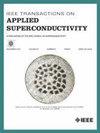Length-Resolved Measurement of Radiation Induced Attenuation in Quench Detection Optical Fibers With Photobleaching
IF 1.7
3区 物理与天体物理
Q3 ENGINEERING, ELECTRICAL & ELECTRONIC
引用次数: 0
Abstract
Fiber-optic temperature and strain measurement systems are a promising technology for quench detection in insulated HTS magnets because of their compact form factor, immunity to electromagnetic noise, and fully dielectric construction. (Salazar et al. 2021) One of the key challenges to implementing these technologies in magnets for fusion devices is that ionizing radiation causes severe attenuation in the quench detection fibers. This attenuation is exacerbated by the low operating temperatures of HTS magnets (猝灭探测光纤光漂白中辐射衰减的长度分辨测量
光纤温度和应变测量系统由于其紧凑的外形、抗电磁噪声和全介电结构,是一种很有前途的绝缘高温超导磁体猝灭检测技术。(Salazar et al. 2021)在核聚变装置的磁体中实施这些技术的关键挑战之一是电离辐射会导致淬灭检测纤维的严重衰减。高温超导磁体的低工作温度(20 K)和电厂规模磁约束聚变系统(200 m)中猝灭检测所需的长光纤长度加剧了这种衰减(Blanc等人,2017年)。在之前的一篇论文中,我们证明了在1550 nm工作的猝灭检测系统的生存剂量可以通过在970 nm连续光漂白延长2000倍以上。(Duke et al. 2024)在这里,我们提出了一项实验,研究了970 nm光漂白对77 K下辐照的显著长度(高达250 m)的纤维的影响,使用一种新的长度分辨测量技术监测1550 nm附近的RIA。
本文章由计算机程序翻译,如有差异,请以英文原文为准。
求助全文
约1分钟内获得全文
求助全文
来源期刊

IEEE Transactions on Applied Superconductivity
工程技术-工程:电子与电气
CiteScore
3.50
自引率
33.30%
发文量
650
审稿时长
2.3 months
期刊介绍:
IEEE Transactions on Applied Superconductivity (TAS) contains articles on the applications of superconductivity and other relevant technology. Electronic applications include analog and digital circuits employing thin films and active devices such as Josephson junctions. Large scale applications include magnets for power applications such as motors and generators, for magnetic resonance, for accelerators, and cable applications such as power transmission.
 求助内容:
求助内容: 应助结果提醒方式:
应助结果提醒方式:


